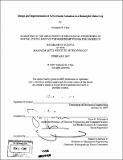Design and implementation of series elastic actuation in a biomorphic robot leg
Author(s)
Chan, Nathaniel K. (Nathaniel Kai Yip)
DownloadFull printable version (1.486Mb)
Other Contributors
Massachusetts Institute of Technology. Dept. of Mechanical Engineering.
Advisor
Steve G. Massaquoi.
Terms of use
Metadata
Show full item recordAbstract
Fluid, efficient, robust bipedal locomotion is hard by some approaches. Today's most advanced bipedal robots require flat and level floors, but are still prone to trips and falls. They have trouble interacting with objects in their surroundings, and adapting to them. We think that new approaches may make bipedal control easier. The following work details the design of the BOB (Bag of Bones) biomorphic robot leg that is a continuation of an effort to achieve a better understanding of the sensorimotor neurocontrol of locomotion, particularly in humans. Such an understanding will not only lead to robots that move as well or better than people while being easier to control, but will also enable powerful therapies for ataxia patients. One of the main design requirements for BOB was to incorporate series elastic actuation, but with hobby servo motors as the power source. The use of hobby servos was intended to keep costs low, as was the extensive use of off the shelf parts whenever possible. With the recent advances in hobby servo motors, it was expected that reasonable if not high performance would be possible. The specific contribution of this work includes the entire series elastic actuation system powered by servo motors. (Cont.) The elements of the actuation system include circular servo horns, wire rope used in loops, turnbuckles, and series elastic elements that use compression springs in extension. It was found that the knee joint can flex from 0 to 90 degrees and back in about 0.7 seconds. Similarly, the ankle cycled from approximately 20 degrees of extension to approximately 35 degrees of flexion in about 0.7 seconds. These performance figures indicate that the gearing ratios at the knee and ankle are appropriate and that the current design is sufficiently powered for walking.
Description
Thesis (S.B.)--Massachusetts Institute of Technology, Dept. of Mechanical Engineering, 2007. Includes bibliographical references (leaf 21).
Date issued
2007Department
Massachusetts Institute of Technology. Department of Mechanical EngineeringPublisher
Massachusetts Institute of Technology
Keywords
Mechanical Engineering.